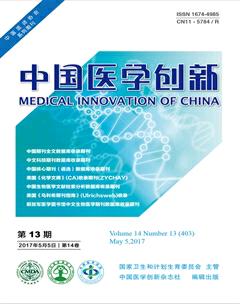心脏再同步治疗除颤器应用于心衰患者的研究现状
李茂林+张卫泽
【摘要】 心脏再同步治疗无论是心脏再同步治疗除颤器(CRT-D)还是心脏再同步治疗起搏器(CRT-P)都被认为是治疗长期慢性心力衰竭的有效手段。在过去的10年里,随着操作人员技术的熟练,符合条件患者数目的增加以及指南的更新,接受心脏再同步治疗的患者成几何倍的增加。但仍然缺少明确的建议来指导CRT-D与CRT-P的选择,本文就心脏再同步治疗除颤器的使用现状及存在的问题做一综述。
【关键词】 心脏再同步治疗除颤器; 心衰; 全因死亡率; 埋藏式心律转复除颤器
【Abstract】 Cardiac resynchronization therapy (CRT) either with a pacing device (CRT-P) or a pacemaker-defibrillator device (CRT-D) is considered an effective treatment for patients with congestive heart failure (CHF).While in the past decades,with skilled operators and technology,the increase in the number of eligible patients and the update of guideline,patients undergoing cardiac resynchronization therapy growed exponentially.But it is still lack of clear advice on how to choice the CRT-D and CRT-P,this paper aim to discuss the use of cardiac resynchronization therapy defibrillators at present and existing problems.
【Key words】 Cardiac resynchronization therapy defibrillators(CRT-D); Heart failure; All-cause mortality; Implantable cardioverter-defibrillator(ICD)
First-authors address:Lanzhou University Second Hosipital,Lanzhou 730050,China
doi:10.3969/j.issn.1674-4985.2017.13.038
心臟再同步治疗(cardiac resynchronization therapy,CRT)是用于中重度心衰患者的植入性治疗器械。经过大量大型试验证实,心脏再同步治疗在改善心衰患者症状、降低住院率、逆转心室重塑、降低全因死亡率方面有显著疗效[1]。根据是否增加一个埋藏式心律转复除颤器,心脏再同步治疗分为:心脏再同步治疗起搏器(cardiac resynchronization therapy with a pacemaker,CRT-P)与心脏再同步治疗除颤器(cardiac resynchronization therapy with a defibrillator,CRT-D)。
关于CRT-P与CRT-D的疗效评价与优先选择一直争议不断,自从COMPANION研究发现心脏再同步治疗除颤器在生存比率方面有相对优越性之后,广泛应用于心衰患者[2]。临床试验证实,心脏再同步治疗可以明显降低死亡率,在COMPANION研究中平均随访16个月,减少了24%;而在CARE-HF研究中平均随访29.4个月,减少了36%。在心脏再同步治疗的基础上再增加一个埋藏式心律转复除颤器,可以再降低8%(对比CRT-P),对于心源性猝死的风险可以降低23%[3]。
1 心脏再同步治疗除颤器的应用现状
一份关于日本从2006-2014年接受心脏再同步治疗患者的调查研究显示[4]:患者选择CRT-D植入对心源性猝死进行初级预防的比列超过80%,于2011年达到顶峰,而从2011-2014年期间逐步减少;选择CRT-P植入的患者比例较少,但从2011-2014年期间逐步增长。
另外一份关于美国从2008-2013年接受心脏再同步治疗的调查研究同样显示[5]:接受CRT-P的患者比例较少,但持续增长,在研究期间从12%增长至20%;同时接受CRT-P的患者更加年长,平均年龄为76岁(对比CRT-D为67岁),而且更加倾向于女性,为40%(对比CRT-D为30%)。
2 心脏再同步治疗除颤器的相关研究
2015年发表于欧洲医学杂志的一项关于CRT-D与埋藏式心律转复除颤器(implantable cardioverter-defibrillaor,ICD)的研究共纳入1499例患者,其中ICD 742例,CRT-D 757例。表明从植入初期开始,CRT-D可以显著减少死亡率,而在减少室颤或快速性室性心律失常方面却没有显著差异,直到植入后6个月后开始才会表现出较低的室颤或快速性室性心律失常[6]。该研究中的患者全部来自于MADIT-RIT试验(第一个包括传统ICD与基于指南筛选的CRT-D患者的大规模随机对照试验),其研究结果具有一定的真实性。但该研究对于研究中不可测量的因素没有做出罗列,且研究分组是既定好的,没有采取随机分组的形式。另外该研究中有超过10%接受CRT-D的患者在后来的随访中转为植入ICD,可能与CRT-D中的心律转复功能丧失有关,需进一步比较心脏再同步化治疗除颤器有无合并CRT-P与CRT-D的功能。
2015年的一项荟萃研究[7],共纳入19项研究,12 378例患者,7030例接受CRT-D,5348例接受CRT-P治疗。其中10项研究表明相对于CRT-P,CRT-D能明显减少死亡率,另9项研究没有发现明显差异。经荟萃分析,CRT-D在降低死亡率方面没有显著优势,但该项研究中接受CRT-D的患者与接受CRT-P的患者存在明显差异,接受CRT-D的患者更年轻,男性居多,有较低的NYHA分级,较少的房颤比例,较高的缺血性心脏疾病发生率,接受CRT-P的患者更年长,心衰程度更重。该项研究还表明:发生缺血性心脏疾病的患者在CRT-D上获益更多,而在非缺血性患者方面,CRT-D与CRT-P无明显差异。
在一个来自于匈牙利国家医疗基金死亡登记表对比CRT-D与CRT-P长期结果的研究中[8],纳入了从2000-2011年的1122例成功植入CRT的患者,其中693例植入CRT-P平均LVEF值(28.2±7.4)%,429例植入CRT-D平均LVEF值(27.6±6.4)%,平均随访28个月,因为各种原因死亡的患者共379例,其中250例患者接受CRT-P植入,129例患者接受CRT-D植入,没有明显的证据表明CRT-D对比CRT-P在减少死亡率方面存在优势(HR=0.98, CI=95%,P=0.884。)在缺血性心肌病患者中,CRT-D对比CRT-P在减少全因死亡率方面有明显优势(HR=0.70,CI=95%,P=0.03)。而在非缺血性心肌病患者中,两者没有明显差异(HR=0.98,CI=95%,P=0.15)。这个超过10年,大容量,单中心的试验表明了CRT-D能明显缺血性心肌病患者的全因死亡率,在这方面的益处要远远超过没有合并ICD的单一CRT-P治疗。
在总体患者中,CRT-D与CRT-P在改善LVEF方面的程度是相似的,尽管在非缺血性患者子集中,CRT-P改善的程度要更好一点。这个研究还存在几点缺陷,首先它是单中心注册表回顾性分析,而且部分患者在接受招募时已经植入CRT超过10年。其次所招募的患者植入CRT-D或是CRT-P主要由临床医生决定,这就导致它本身不是一个随机性治疗可能存在选择偏差。
3 心脏再同步治疗除颤器存在的问题
心脏再同步治疗合并双心室起搏器(CRT-P)是一种非常有效的治疗方法对于非同步性心衰患者,再增加一个埋藏式心律转复除颤器(CRT-D)会进一步减少心源性猝死的风险。但如果大部分病人不需要除颤治疗,而CRT-D的成本确比CRT-P要高。一项采用经济评估模型分析CRT-D的成本有效性的研究于2016年发表于欧洲卫生经济学杂志的研究检索了大部分数据库中从2000年
1月-2014年12月的文献[9]后发现,对比理想药物治疗时,CRT-D的成本花费是有效的,而在对比CRT-P时确不明显。
另外一项关于瑞典10年间心脏再同步治疗除颤器及埋藏式心律转复除颤器花费的研究表明,瑞典每年在设备植入中投入巨大,而随着心脏再同步治疗除颤器延长的电寿命,于2015年所有的花费都折扣为财政支出的3%[10]。文献[11]表明,在调查的10年间为瑞典减少了2820例更换及24.93亿的财政支出。
心脏再同步治疗除颤器已经表明了其在减少死亡率、改善症状及提高生存质量方面对比埋藏式心律转复除颤器的优势。但仍然没有准确的数据显示在CRT的基础上增加一个ICD能使符合CRT植入的心衰患者获得额外收益,虽然理论上这种组合能减少快速性心律失常引起的死亡风险。尽管缺乏证据,但CRT-D仍然在没有任何严格建议的情况下在对心衰患者的使用上优先于CRT-P。
然而,决定植入CRT-D或者CRT-P一直是一个有争议的问题。COMPANION试验研究了CRT-D、CRT-P对比最佳药物治疗,但没有直接对比CRT-D与CRT-P,而它的研究目的也并不是旨在回答这个问题[12-14]。几个Meta分析对比CRT-D与CRT-P的效果在哪些具备初步指征植入ICD的患者,然而事与愿违,并没有表明在CRT的基础上增加一个ICD能为这些患者带来明显益处[15-18]。此外,CRT-D有更高的成本及更低的成本效益比,同时混合ICD组成的CRT-D系统将会导致更高并发症的风险。目前对于适合CRT植入的最佳患者选择并无统一意见,分析识别出哪些患者最可能从单独植入CRT-P中获益更多,是非常缺乏但必要的。
CARE-HF試验对比了CRT-P与标准药物治疗,发现接受CRT-P治疗能明显减少全因死亡率。而且在对CARE-HF试验中招募的患者延长随访中发现,对比标准药物治疗,CRT-P能明显减少心源性猝死[19-22]。另外的几个研究发现CRT-P之所以能减少快速性心律失常及心源性猝死是因为逆转心室重塑作用以及CRT作用于神经激素系统方面的结果[23-26]。
目前仍没有就哪些患者能从CRT-P中获益最多达成共识,临床医生仍需要根据个体患者,评估成本、效益及风险,对于CRT-D与CRT-P做出最佳选择。
毫无疑问,CRT-D通过延缓心衰进展、更健康的生活质量给予心衰患者积极的影响,但其高昂的费用也给社会带来巨大的负担。这就要求提高患者对心脏再同步治疗的应答比列或筛选出不需要额外增加埋藏式心律转复除颤器的患者。
参考文献
[1] Chinitz J S,DAvila A,Goldman M,et al.Cardiac Resynchronization Therapy:Who Benefits[J].Annals of Global Health,2014,80(1):61-68.
[2] Bristow M,Saxon L,Boehmer J,et al.Cardiac-resynchronization therapy with or without an implantable fibrillator in advanced chronic heart failure[J].N Eng1 J Med,2014,(350):2140-2150.
[3] Mealing S,Woods B,Hawkins N,et al.Cost-effectiveness of implantable cardiac devices in patients with systolic heart failure[J].Heart,2016,102(21):1742-1749.
[4] Yokoshiki H,Shimizu A,Mitsuhashi T,et al.Trends and determinant factors in the use of cardiac resynchronization therapy devices in Japan:Analysis of the Japan cardiac device treatment registry database[J].Journal of Arrhythmia,2016,32(6):486-490.
[5] Hatfield L A,Kramer D B,Volya R,et al.Geographic and Temporal Variation in Cardiac Implanted Electric Devices to Treat Heart Failure[J].Journal of the American Heart Association Cardiovascular & Cerebrovascular Disease,2016,5(8):3532.
[6] Stockburger M,Moss A J,Olshansky B,et al.Time-dependent risk reduction of ventricular tachyarrhythmias in cardiac resynchronization therapy patients:a MADIT-RIT sub-study[J].Europace,2015,17(7):1085-1091.
[7] Sérgio B,Rui P,Tang A,et al.Importance of Implantable Cardioverter-Defibrillator Back‐Up in Cardiac Resynchronization Therapy Recipients:A Systematic Review and Meta‐Analysis[J].Journal of the American Heart Association Cardiovascular & Cerebrovascular Disease,2015,4(11):89-91.
[8] Kutyifa V,Geller L,Bogyi P,et al.Effect of cardiac resynchronization therapy with implantable cardioverter defibrillator versus cardiac resynchronization therapy with pacemaker on mortality in heart failure patients:results of a highvolume,singlecentre experience[J].European Journal of Heart Failure,2014,16(12):1323-1330.
[9] Tomini F,Prinzen F,van Asselt A D.A review of economic evaluation models for cardiac resynchronization therapy with implantable cardioverter defibrillators in patients with heart failure[J].European Journal of Health Economics Hepac Health Economics in Prevention & Care,2016,17(7):1159-1172.
[10] Gadler F,Ding Y,Verin N,et al.Economic impact of longer battery life of cardiac resynchronization therapy defibrillators in Sweden[J].Clinicoeconomics & Outcomes Research Ceor,2016,8:657-666.
[11] Gold M R,Daubert J C,Abraham W T,et al.Implantable defibrillators improve survival in patients with mildly symptomatic heart failure receiving cardiac resynchronization therapy:analysis of the long-term follow-up of remodeling in systolic left ventricular dysfunction(REVERSE)[J].Circ Arrhythm Electrophysiol,2013,6(6):1163-1168.
[12] Morani G,Gasparini M,Zanon F,et al.Cardiac resynchronization therapy-defibrillator improves long-term survival compared with cardiac resynchronization therapy-pacemaker in patients with a class IA indication for cardiac resynchronization therapy:data from the Contak Italian Registry[J].Europace,2013,15(9):1273-1279.
[13] Nigussie B,Silvia P,Cleland J G F,et al.The European CRT Survey:1 year (9-15 months) follow-up results[J].European Journal of Heart Failure,2012,14(1):61-73.
[14] Gurunathan B,Sahadevan R.Reverse remodeling and the risk of ventricular tachyarrhythmias in the MADIT-CRT(Multicenter Automatic Defibrillator Implantation Trial-Cardiac Resynchronization Therapy)[J].Journal of the American College of Cardiology,2011,57(24):2416.
[15] Schuger C,Daubert J P,Brown M W,et al.Multicenter automatic defibrillator implantation trial:reduce inappropriate therapy(MADIT-RIT):background,rationale,and clinical protocol[J].Annals of Noninvasive Electrocardiology,2012,17(17):176-185.
[16] Moss A J,Schuger C,Beck C A,et al.Reduction in inappropriate therapy and mortality through ICD programming[J].Revista Portuguesa De Cardiologia,2012,367(24):2275-2283.
[17] Marijon E,Leclercq C,Narayanan K,et al.Causes-of-death analysis of patients with cardiac resynchronization therapy:an analysis of the CeRtiTuDe cohort study[J]. European Heart Journal,2015,36(41):2767-2776.
[19] Ganesan A N,Brooks A G,Roberts-Thomson K C,et al.Role of AV Nodal Ablation in Cardiac Resynchronization in Patients With Coexistent Atrial Fibrillation and Heart Failure:A Systematic Review[J].Journal of the American College of Cardiology,2012,59(8):719-726.
[19] Gillebert C,Marynissen T,Janssen R,et al.How to choose between a pacemaker or defibrillator for resynchronization therapy[J].Acta Cardiologicu,2014,69(5):483-489.
[20] Reitan C,Chaudhry U,Bakos Z,et al.Long-Term Results of Cardiac Resynchronization Therapy:A Comparison between CRT-Pacemakers versus Primary Prophylactic CRT-Defibrillators[J].Pacing & Clinical Electrophysiology,2015,38(6):758-767.
[21] Witt C T,Kronborg M B,Nohr E A,et al.Adding the implantable cardioverter-defibrillator to cardiac resynchronization therapy is associated with improved long-term survival in ischaemic,but not in non-ischaemic cardiomyopathy[J].Europace,2015,(3):212.
[22] Dodson J A,Lampert R,Wang Y,et al.Temporal trends in quality of care among recipients of implantable cardioverter-defibrillators:insights from the National Cardiovascular Data Registry[J].Circulation,2014,129(5):580-586.
[23] Schneider P M,Pellegrini C N,Wang Y,et al.Prevalence of guideline-directed medical therapy among patients receiving cardiac resynchronization therapy defibrillator implantation in the National Cardiovascular Data Registry during the years 2006 to 2008[J].American Journal of Cardiology,2014,113(12):2052-2056.
[24] Meeker D,Linder J A,Fox C R,et al.Effect of Behavioral Interventions on Inappropriate Antibiotic Prescribing Among Primary Care Practices:A Randomized Clinical Trial[J].Jama the Journal of the American Medical Association,2016,315(6):562-570.
[25] Kramer D B,Buxton A E,Zimetbaum P J.Time for a change-a new approach to ICD replacement[J].N Engl J Med,2012,366(4):291-293.
[26] Rickard J,Bassiouny M,Tedford R J,et al.Long-term outcomes in patients with ambulatory new york heart association class III and IV heart failure undergoing cardiac resynchronization therapy[J].American Journal of Cardiology,2015,115(1):82-85.
(收稿日期:2017-03-15) (本文編辑:周亚杰)

